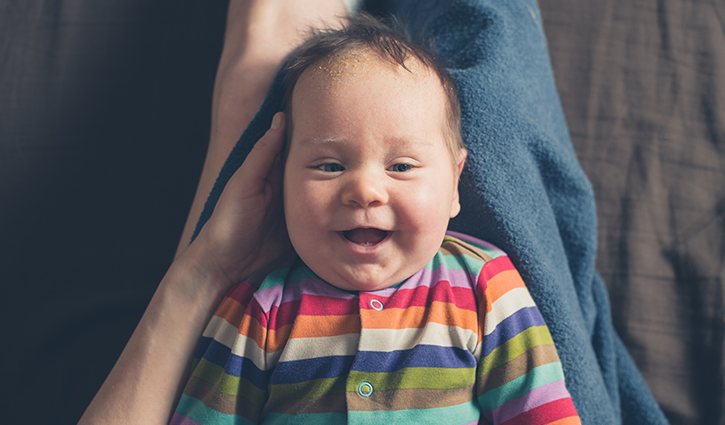

Has your baby’s beautiful little head started to develop some yellowish, oily, scaly crusts? It’s called cradle cap, and there’s no need for concern because it:
- usually doesn’t cause any discomfort or itchiness for babies
- is a very common condition in the first two months
- is completely harmless
- tends to only last a few weeks or months
- isn’t contagious
- usually clears up by itself
- won’t cause any long-term hair loss or baldness
- not caused by lack of cleanliness, and in fact, excessive washing can make it worse
What causes cradle cap?
The cause of cradle cap isn’t entirely clear, but it’s thought that it happens when a baby’s skin makes too much oil called ‘sebum’, probably due to mum’s hormones still circulating around in the baby’s system.
The extra oil that’s produced interferes with the natural shedding of skin on the scalp, so a build up of dead skin occurs.
Cradle cap may also happen when a baby’s immature immune system overreacts to the yeast on the scalp, which then causes inflammation.
How to treat cradle cap
Cradle cap can spread to your baby’s eyebrows and behind their ears. The scaly patches can sometimes be found on other parts of the body too, such as up their nose, in their nappy region, armpits, and backs of their knees.
You may have tried peeling off the crust but found it doesn’t come off very easily, or you might find it looks inflamed or irritated under the scales. A little hair may also come out with it.
It’s important not to pick or scratch at the cradle cap as it can get infected.
It will clear up on its own with time, but you can help it along by getting rid of the crusts. Just follow these two simple steps each day:
- In the bath, use a mild, nourishing baby shampoo with added moisturising properties to keep your baby’s scalp from becoming dry.
- After the bath, the crusts will have softened. As often as needed, use a natural baby cradle cap lotion along with a soft brush to loosen and gently remove the crusts. No pressure is needed, so be careful not to force the crusts off or they could bleed.
When to seek medical advice
Your baby most likely won’t need to see a doctor about their cradle cap, except for the following reasons.
- If the cradle cap doesn’t improve after two weeks of treating it as above or you’re not sure whether it’s cradle cap.
- If your baby seems irritated by it, the crusts or skin around them are inflamed or weeping. Your doctor might prescribe a combination of mild corticosteroid and anti-yeast cream. Sometimes an over-the-counter anti-dandruff or cradle cap shampoo is recommended, but take extra care with these shampoos as they are stronger than baby shampoo. Avoid getting it in your baby’s eyes and discontinue use if it gets worse.
- It it continues past 3 months or appears to be itchy, in which case it could be eczema which will need a different treatment.
- Always take your baby to the GP if they have signs of an infection, including a fever, poor feeding, or tiredness.
How to prevent cradle cap from recurring
If it comes back again after treatment, there’s no need to worry. It just means that your baby is still making extra oil. Simply go through the treatment steps again to nip it in the bud. It usually completely clears up between 6-12 months.























